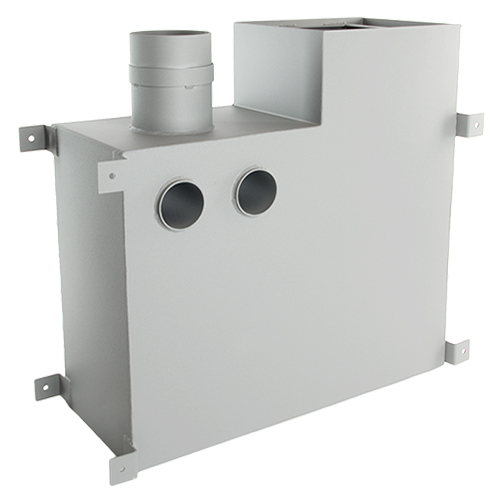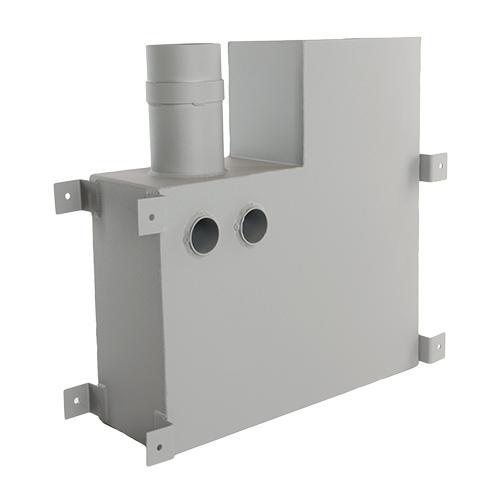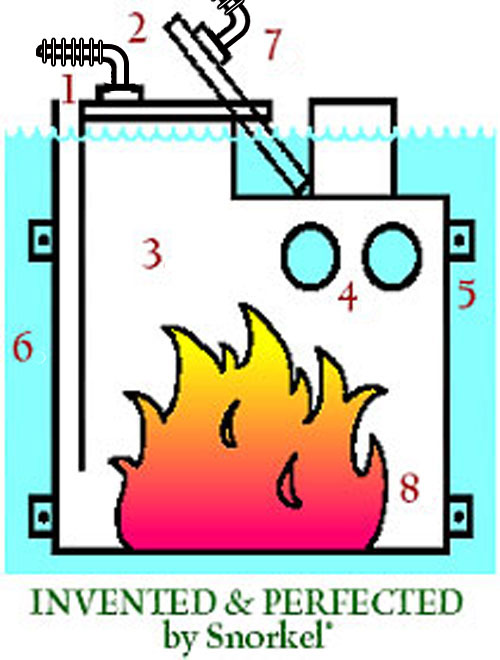We invented the underwater woodstove
and introduced wood-fired hot tubbing to North America

The original Snorkel® Stove was created by Roger Evans while he was a physics student at the University of Alaska in Fairbanks. The concept of wood-fired hot tubbing was so appealing to family and friends that Roger and skiing buddy Blair Howe formed a company to market the stove and wood hot tubs.
The concept of the underwater wood stove for hot tubs was so unique that it was awarded a United States Patent, number 4455997, in 1981. The Scuba® Stove was developed later and is a smaller version of the Snorkel® Stove designed for smaller hot tubs.
Simplicity and Efficiency
The beauty of our underwater stoves is their simplicity and efficiency.
The basic design and operation of the Snorkel® Stove are very simple. It works just like any other wood stove or fireplace, as shown. The only real difference is the fact that the burning chamber is submerged.
- Above-water air intake
- Stove door/air regulator
- Underwater firebox
- Heat exchange tubes
- Mounting brackets
- Corrosion-proof powder-coat finish
- Cast aluminum door won’t rust or warp
- Simple and easy to clean
Snorkel® stoves: 120,000 BTU, standard with 6’ and larger diameter tubs
Scuba® stoves: 60,000 BTU, standard with 4’ and 5’ diameter tubs
Take a closer look:
Our underwater woodstove is in complete, direct contact with the water it heats. Only the air intake and chimney are above water. Open the cast aluminum door (7) to load wood. Light the fire and place door as shown (2) for maximum draft. Slide door over air intake (1) as needed to reduce draft. The aluminum firebox (3) heats quickly. Heat exchanger tubes (4) increase the stove’s surface for even faster heating.
How does it work?
Even though our Snorkel® and Scuba® wood stoves are submerged UNDERWATER, water can’t get in. Seams are welded and only the air intake “snorkel” and smokestack are above the water line. Our stoves operate just like an ordinary wood stove or fireplace.
To build a fire: place crumpled paper in the bottom of the stove. Put kindling on top, then add small logs or split pieces of wood. Light the paper and leave the air intake fully open. A good draft will immediately establish itself. Once the fire is going strong, add larger logs and split wood.
To control the rate of burn, open or close the air intake by sliding the stove door forward or back. Because the entire stove surface is submerged, heat from the fire transfers to the water immediately. That’s all there is to it!
Cleaning out the ashes is simple. We include our stainless steel ash scoop with every wood-fired hot tub purchase. Even easier, if electricity is available, wait until all the embers are cold and use a shop vac.
Why is the stove UNDER WATER?
Our wood stoves sit underwater – all but the feed inlet and chimney stack. Complete water contact with almost all surfaces of the stove allows super-efficient heat transfer. In addition, the aluminum body conducts heat 16x faster than stainless steel.
Because of the direct contact with the tub water and super-fast heat conduction of aluminum, our underwater stoves heat hours quicker than external wood-burning heaters. External wood stove heaters depend upon the thermo-siphon effect to move water to the tub. This is a workable, but very slow and inefficient way to heat the tub water.
With the stove in the tub a quick freeze isn’t a problem as it takes days, even a week or two of below freezing weather to freeze the tub solid. For external stoves, a quick freeze can cause the water in the externally mounted pipes and the stove water jacket to freeze within hours and burst the pipes and water jacket.
What is the difference between the Snorkel® and Scuba® Stoves?
The Scuba® Stove is just a smaller version of the Snorkel® Stove. It is intended for tubs five feet in diameter and less. The design for the two stoves is the same. For more information, see Designing Your Snorkel® Hot Tub.

SNORKEL® STOVE

SCUBA® STOVE
High-tech construction
Our stove body components are precision-cut with plasma cutting machines. Then high-tech bending equipment is used to form the body parts. Next, and a little less high tech is the personal touch, our stoves are hand welded on every seam and inspected.
The finishing touch is that every stove is powder coated. We do this because many water supplies contain concentrations of minerals like calcium and magnesium that can corrode even the highest quality metal alloys if they’re not protected. Powder coating protection allows us to back our stoves with a 3-Year Warranty
Enjoy your hot tub anywhere
With the hot tub and stove being an integrated component, you can easily enjoy your hot tub anywhere. All you need is wood, water and a match. Want to move it? Two people can easily turn it on its side and roll it into a truck bed…or even enjoy it on the truck bed!
Operating Expenses: $O
“Operating cost is where the real money gets spent. With Snorkel’s wood heat and well water, my cost is $0. I didn’t want to spend money heating water.”
—Dania Egedi, Corbin KY
The high-efficiency Snorkel® and Scuba® wood-burning stove s-q-u-e-e-z-e maximum heat from firewood: it’s reduced to fine ashes.
You can heat your Snorkel® Hot Tub with virtually ANY wood: cut and split firewood, scraps of lumber, fallen branches, cut-up wooden pallets, even coal – though you must install a grate to burn coal. And wood heat is ECONOMICAL, too!
Because of the fast heat up times and the low cost of the heat, many of our customers adopt the Japanese style of hot tubbing. That is, they change the water frequently and don’t use chemicals. They simply fill the tub with fresh water; heat and enjoy a few times; then empty the tub. Scrub lightly with a dilute bleach solution and refill. True Japanese tradition would include a complete cleansing shower for each bather before entering the tub.

